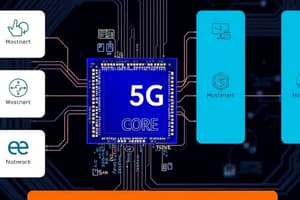Podcast
Questions and Answers
Within the architectural framework supporting VoWiFi in EPC, what functional entity is responsible for providing secure tunneling for untrusted WiFi access, while also encapsulating and securing the IP packets?
Within the architectural framework supporting VoWiFi in EPC, what functional entity is responsible for providing secure tunneling for untrusted WiFi access, while also encapsulating and securing the IP packets?
- Trusted Wireless Access Gateway (TWAG)
- Serving Gateway (SGW)
- Packet Data Network Gateway (PGW)
- Evolved Packet Data Gateway (ePDG) (correct)
In 5G authentication, the Access and Mobility Management Function (AMF) directly interfaces only with the Authentication Server Function (AUSF) for authentication vectors, bypassing the need for interaction with the Unified Data Management (UDM) in standalone non-roaming architectures.
In 5G authentication, the Access and Mobility Management Function (AMF) directly interfaces only with the Authentication Server Function (AUSF) for authentication vectors, bypassing the need for interaction with the Unified Data Management (UDM) in standalone non-roaming architectures.
False (B)
Describe the mechanism by which the N3IWF (Non-3GPP Interworking Function) facilitates secure and authenticated access for untrusted Wi-Fi devices connecting to a 5G core network, highlighting the key protocol transformations and security procedures involved.
Describe the mechanism by which the N3IWF (Non-3GPP Interworking Function) facilitates secure and authenticated access for untrusted Wi-Fi devices connecting to a 5G core network, highlighting the key protocol transformations and security procedures involved.
The N3IWF utilizes the EAP-AKA' authentication protocol to mutually authenticate the UE and the network, establishing a secure tunnel over which user plane data is transmitted. It bridges the non-3GPP access network with the 5G core by translating protocols and enforcing security policies.
The ______ is primarily responsible for binding a UE to a specific network slice instance, ensuring that policy and charging rules are appropriately applied based on the selected slice.
The ______ is primarily responsible for binding a UE to a specific network slice instance, ensuring that policy and charging rules are appropriately applied based on the selected slice.
Match the following 5G Core network functions with their respective roles in network slicing:
Match the following 5G Core network functions with their respective roles in network slicing:
In the context of 5G network slicing, which of the following options correctly describes the relationship between a PDU (Protocol Data Unit) session and a PLMN (Public Land Mobile Network)?
In the context of 5G network slicing, which of the following options correctly describes the relationship between a PDU (Protocol Data Unit) session and a PLMN (Public Land Mobile Network)?
The S-NSSAI (Single Network Slice Selection Assistance Information) is exclusively composed of the Slice/Service Type (SST) component, and the Slice Differentiator (SD) is only applicable in non-standard implementations.
The S-NSSAI (Single Network Slice Selection Assistance Information) is exclusively composed of the Slice/Service Type (SST) component, and the Slice Differentiator (SD) is only applicable in non-standard implementations.
Describe different types of S-NSSAI types while explaining their roles in network slice selection.
Describe different types of S-NSSAI types while explaining their roles in network slice selection.
The Network Slice Selection Function (NSSF) uses the ______ to determine the appropriate AMF (Access and Mobility Management Function) for a UE based on its requested network slice.
The Network Slice Selection Function (NSSF) uses the ______ to determine the appropriate AMF (Access and Mobility Management Function) for a UE based on its requested network slice.
Match the following 5G authentication entities with their respective functions:
Match the following 5G authentication entities with their respective functions:
In the context of network slicing, what is the significance of the Network Slice Selection Assistance Information (NSSAI) during initial UE registration?
In the context of network slicing, what is the significance of the Network Slice Selection Assistance Information (NSSAI) during initial UE registration?
In 5G network slicing, the User Plane Function (UPF) can dynamically switch a user's data session between different network slices based on real-time application demands without requiring a new PDU session establishment.
In 5G network slicing, the User Plane Function (UPF) can dynamically switch a user's data session between different network slices based on real-time application demands without requiring a new PDU session establishment.
Outline the key steps involved in the network slice selection process within a 5G network, from initial UE request to the establishment of a data session within the selected slice.
Outline the key steps involved in the network slice selection process within a 5G network, from initial UE request to the establishment of a data session within the selected slice.
In 5G, the function responsible for the interworking between 3GPP and non-3GPP access networks, providing secure connectivity for untrusted Wi-Fi access, is known as the ______.
In 5G, the function responsible for the interworking between 3GPP and non-3GPP access networks, providing secure connectivity for untrusted Wi-Fi access, is known as the ______.
Match the following terms related to network slicing with their corresponding definitions:
Match the following terms related to network slicing with their corresponding definitions:
Which of the following poses the most critical challenge in the implementation and management of end-to-end network slicing across a multi-vendor 5G network environment?
Which of the following poses the most critical challenge in the implementation and management of end-to-end network slicing across a multi-vendor 5G network environment?
In a 5G Standalone (SA) architecture, the evolved Node B (eNodeB) from LTE is directly reused for providing radio access, thereby eliminating the need for a new generation of radio access network (RAN) equipment.
In a 5G Standalone (SA) architecture, the evolved Node B (eNodeB) from LTE is directly reused for providing radio access, thereby eliminating the need for a new generation of radio access network (RAN) equipment.
Describe the procedure by which a UE, initially connected to a network slice dedicated to enhanced Mobile Broadband (eMBB), can dynamically transition to a different network slice optimized for Ultra-Reliable Low Latency Communications (URLLC) while maintaining session continuity.
Describe the procedure by which a UE, initially connected to a network slice dedicated to enhanced Mobile Broadband (eMBB), can dynamically transition to a different network slice optimized for Ultra-Reliable Low Latency Communications (URLLC) while maintaining session continuity.
The ______ function in 5G is responsible for supporting the discovery of network slice instances based on specific service requirements and operator policies.
The ______ function in 5G is responsible for supporting the discovery of network slice instances based on specific service requirements and operator policies.
Match the architectural components with their functional categories:
Match the architectural components with their functional categories:
Flashcards
Network Slice
Network Slice
A logical network providing specific network capabilities and characteristics.
Network Slice Instance
Network Slice Instance
Instances of network functions and resources forming a deployed network slice.
NSSAI
NSSAI
Information aiding in the selection of a suitable network slice.
S-NSSAI
S-NSSAI
Signup and view all the flashcards
Subscribed S-NSSAI
Subscribed S-NSSAI
Signup and view all the flashcards
Configured S-NSSAI
Configured S-NSSAI
Signup and view all the flashcards
Study Notes
Authentication and Network Slicing
- The session covers authentication and network slicing in the context of 5G core networks.
VoWiFi in EPC
- Voice over Wi-Fi (VoWiFi) in Evolved Packet Core (EPC) architecture uses components like MME, HSS, PCRF, SGW, PGW, and IMS
- It involves trusted and untrusted Wi-Fi networks connecting through TWAG, AAA, and ePDG.
Non-3GPP Access in 5GC
- Non-3GPP access in 5G Core (5GC) includes network functions such as NSSF, AUSF, NEF, NRF, UDM, PCF, AMF, SMF, UPF, and AF
- It utilizes N3IWF (Non-3GPP Interworking Function) for untrusted Wi-Fi access and involves entities like NG UE (Next Generation User Equipment).
Authentication in 5GC - EAP
- 5GC authentication with EAP supports SIM-based, non-SIM, and untrusted non-3GPP devices.
- SIM-based devices use IMSI + AKA keys, while SIM-less devices use ID/IMSI + non-AKA.
- Authentication involves UDM, AMF, and AUSF entities.
Authentication Architecture – 5G AKA
- 5G Authentication and Key Agreement (AKA) architecture includes UDM (ARPF), AMF (SEAF), and AUSF.
- SIM-based UEs use IMSI + AKA for authentication over 5G-RAN and non-3GPP networks.
Network Slicing - Terms
- Network Slice: Logical network providing specific network capabilities and characteristics.
- Network Slice Instance (NSI): Set of network function instances and required resources forming a deployed network slice.
- Network Slice Selection Assistance Information (NSSAI): Information used for network slice selection.
5G Network Slicing Introduction
- A network slice may include components such as 5GC Control Plane (CP), User Plane (UP) NFs, 5G Radio Access Network (RAN), and N3IWF for non-3GPP Access Network.
- A UE can be simultaneously served by one or more Network Slice instances via 5G-AN.
- A single PDU session can only belong to one Network Slice instance per PLMN (Public Land Mobile Network).
- Different slices support slice-specific PDU sessions using the same DNN (Data Network Name).
NGMN
- NGMN (Next Generation Mobile Networks) Alliance comprises of Member, Contributor, and Advisor Partners.
- Member Partners are Operators with over 200 networks.
- It has more than 60% of all global customers.
- The vision of the NGMN Alliance is to expand communications and its focus on 5G development.
- More information is available at https://www.ngmn.org/home/html.
NGMN - Network Slicing terminology
- Network slicing involves Service Instance Layer, Network Slice Instance Layer, and Resource Layer with components like AMF, PCF, NEF, and NRF.
S-NSSAI
- S-NSSAI (Single Network Slice Selection Assistance Information) identifies a network slice across the 5GC, 5G-RAN, and the UE.
- S-NSSAI format includes Mandatory SST (Slice/Service Type) of 8 bits and Optional SD (Slice Differentiator) of 24 bits
Types of S-NSSAI
- Subscribed S-NSSAI is stored in the UDM and used as a default when the UE does not send a requested NSSAI.
- Configured S-NSSAI is configured by the PLMN in the UE and used as its default NSSAI.
- Allowed S-NSSAI is assigned by the 5GC and valid in a Registration Area or the PLMN over a given access type.
- Requested S-NSSAI is sent by the UE to the RAN as part of the registration request for AMF selection and validation.
- Rejected S-NSSAI can be rejected by 5GC for an area.
Network Slice Selection
- Network Slice Selection
- Involves UDM, NSSF, 5G-RAN, Initial AMF, and Serving AMF entities.
- Utilizes Subscribed NSSAI, Requested NSSAI, Allowed NSSAI, and Rejected NSSAI.
5GS Network slicing introduction
- Network Functions (NFs) can be shared across network slices.
- RAN (shared resource in gNB)
- Network Slice Instance #0 (NSI #0) S-UDM, S-NRF
- Network Slice Instance #1 (NSI #1)S-UDM, S-SMF
- Network Slice Instance #2 (NSI #2)S-AMF, S-NRF, S-SMF
5GS Network slicing introduction
- RAN is typically shared between different Network Slices.
- A device is typically connected to a single Network Slice while simultaneously connecting to Multiple Networked Slices
- Network Slice selection is typically performed seldom, for example at initial Registration.
- The Core Network part of the Network Slice contains different sets of functionality.
Network Slice selection in 5GS
- The NS selection consists of:
- Supported Slices
- NS selection assistance Information
- SMF Selection Request
- Network Slices are shared across nw slices: S-NSS, S-NRF, S-UDM.
Network Slicing in 5G
- A device connected simultaneously to multiple Network Slices is served by a single AMF
- The AMF is shared across the NSs
- The Specific part of the NS CN provides both isolation on different levels and different functionality in different Network Slices
Studying That Suits You
Use AI to generate personalized quizzes and flashcards to suit your learning preferences.




